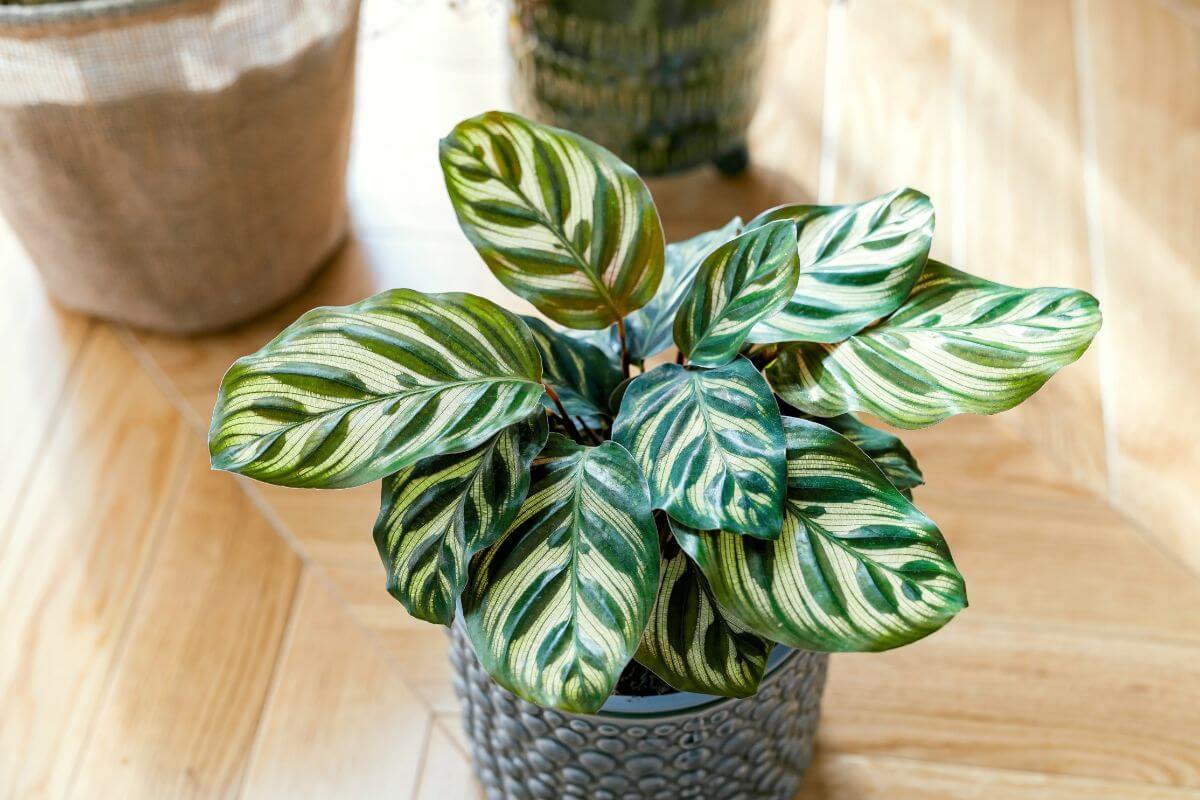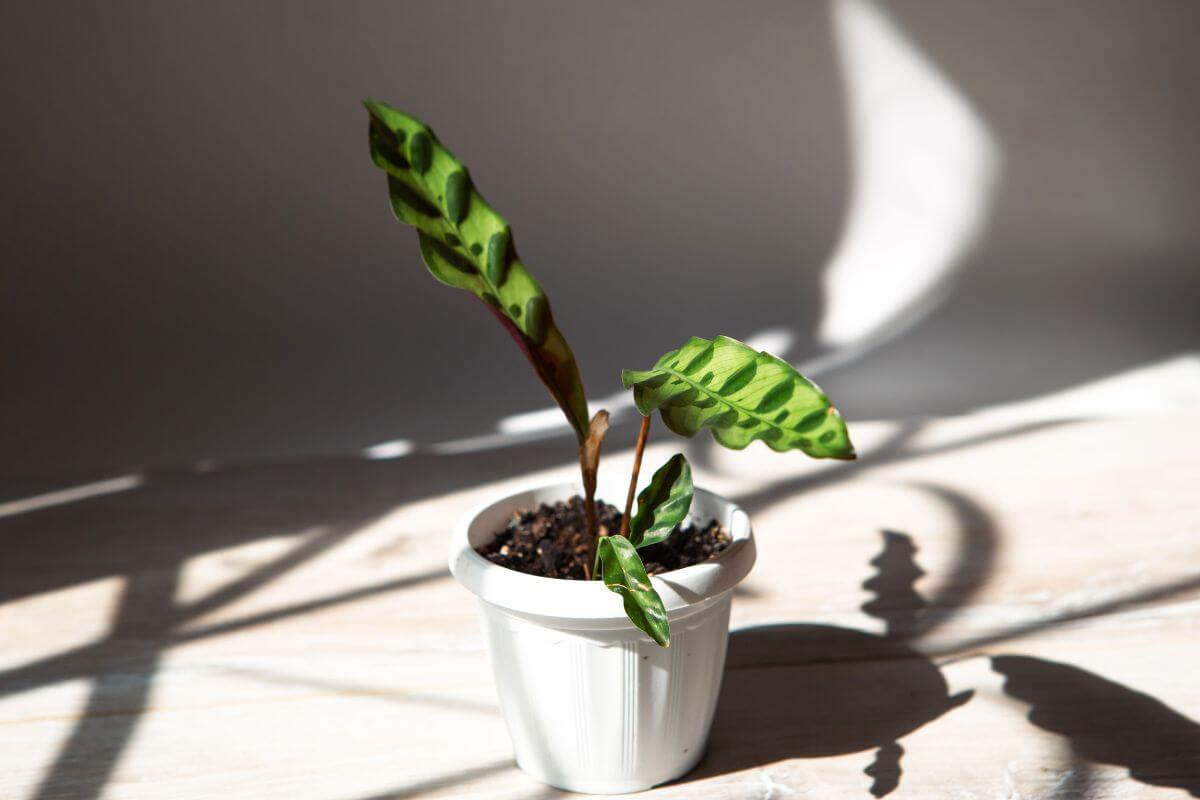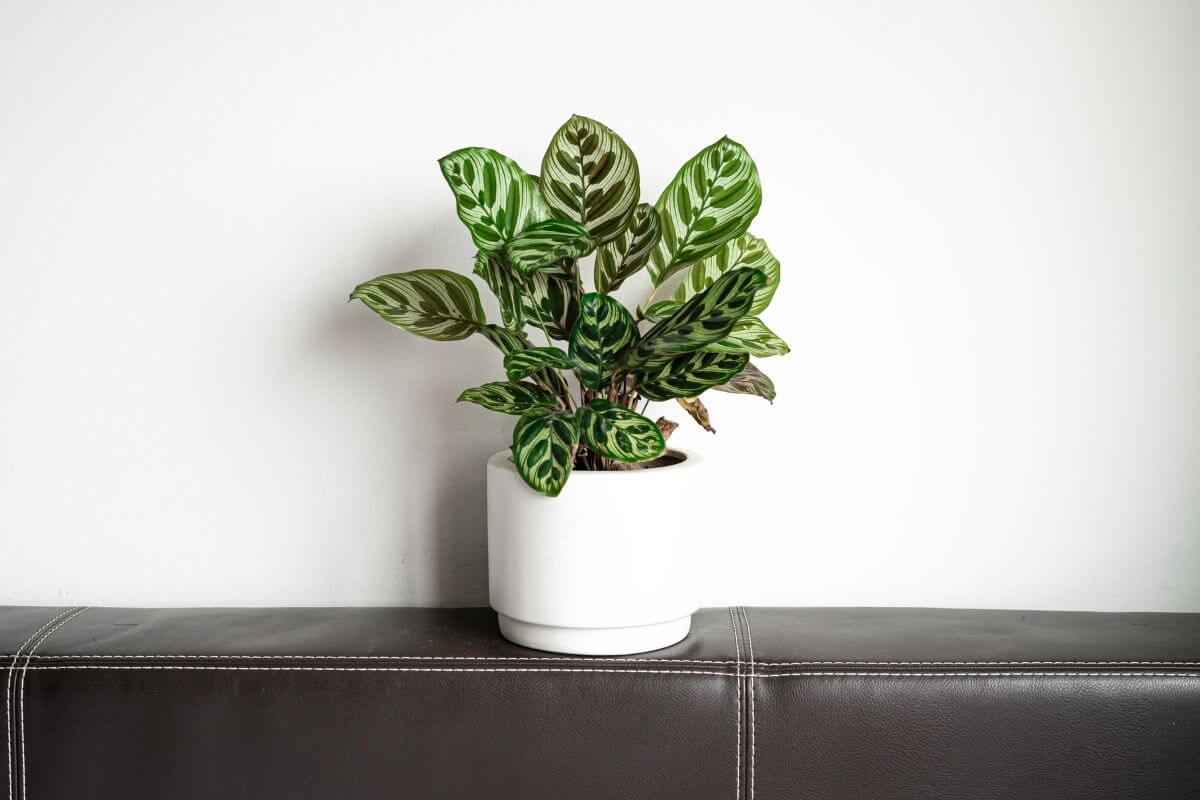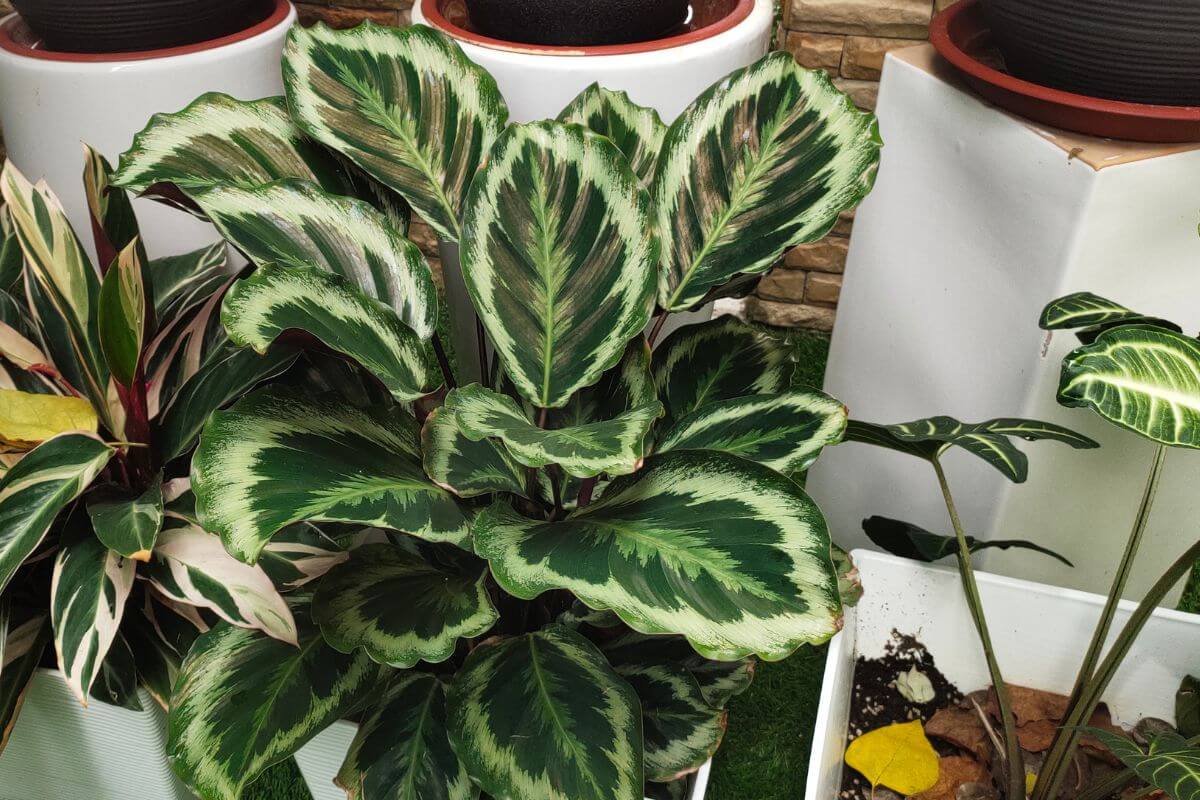A colorful tropical plant, the Calathea is a popular houseplant thanks to leaves that come in a variety of shapes and sizes.
It is an easy plant to grow that’s great for beginners because it grows quickly and looks beautiful.They are colorful indoor plants with stripes or patterned leaf tops and dark purple undersides.
- Related: Houseplant Background
This guide will show you how to grow and care for calathea plants successfully.
Calathea Plant Overview

They belong to the same family as the Prayer Plant, the Marantaceae family. They share the characteristic that they are a nyctinasty species. Their green leaves fold close at night and open in the morning.
Native to Brazil, the calathea is a herbaceous perennial that loves the tropics. Another popular name for it is the Beauty Star.
There are dozens of beautiful and colorful calathea varieties of calathea plants to choose from. Among these we find:
- Calathea ornata (Pinstripe Calathea)
- Calathea lancifolia (Rattlesnake Plant)
- Calathea makoyana (Peacock Plant)
- Calathea musaica (Network Calathea)
- Calathea veitchiana (Medallion Calathea)
- Calathea roseopicta (Calathea Dottie)
- Calathea rufibarba (Furry Feather)
Calathea Plant Care Guide
Although it has a reputation as a finicky houseplant, once the correct conditions are established, this is a relatively easy plant to care for.
Soil for the Calathea Plant
A good potting medium for growing a calathea at home will be soil that retains moisture, but drains well at the same time. A standard potting soil will work if it is aerated often.
If you want to try aerating your soil bed, gently poke some holes in the soil bed’s surface. To aerate, I use a mini spade, but you don’t need any special gardening tools.
A chopstick or even a knife can be used to gently loosen up the soil to help encourage water and air circulation.
If you want to buy any ready-to-use potting mix, you can buy African Violet soil mix for healthy growth as it’s a good fit for calathea plants. The soil’s pH level should also be acidic at 6.5.
Light for the Calathea Plant

The natural environment of the calathea plant is the tropical rainforest where they grow on the floor of the jungle. The light they receive there is filtered through the canopy of trees that tower above them.
Therefore, they will not need or want bright direct light or direct sun exposure. This will be too strong and harsh for these plants. When exposed to direct bright light, the foliage will lose its color and the leaves may scorch.
These plants do better in medium, indirect light. They should thrive in windows facing either east or west. A south-facing window can also be a good possibility if the window has blinds or a sheer curtain, or if your home is surrounded by trees that create partial shade.
These plants will also adapt to low light but will grow more slowly. Try to give it at least a medium light level.
Water for the Calathea Plant
An evenly and constantly moist soil bed is ideal, but soggy soil will create health problems for the calathea.
When the top inch of the soil bed is dry, water your calathea thoroughly. Drainage of excess water is also necessary to prevent root rot.
The calathea may exhibit sensitivity to the water quality too. Keep an eye out for brown leaf tips to know if the type of water used is causing any issues.
Water that is hard, soft, or fluoridated will turn leaf edges brown and perhaps even lead to leaf burn.
Distilled water would be the preferred choice, but rainwater or tap water that has been filtered will do as well. If you have chlorine in your tap water, let the water sit in the open air for 24 hours to dechlorinate water.
Humidity for the Calathea Plant
As a tropical plant, the calathea loves higher levels of humidity. The humidity level needs to be higher than what is present in a normal home.
It is important to be aware of this in the winter when heaters and central heating dry the air out even more.
Bathrooms make for great rooms to place a plant as that’s a regular place for higher humidity.
If you cannot or prefer not to position this plant in a steamy bathroom, you can compensate with one of the following methods to increase humidity levels.
- Use a humidifier for plants.
- Place a pebble tray underneath your calathea pot. Fill a tray with stones or pebbles and with water. Position your plant on the tray but in such a way that the container bottom does not come into contact with the water. As the water naturally evaporates, the surrounding humidity will increase.
- Group houseplants together. A cluster of plants is one way to increase the surrounding humidity. Because plants transpire, they release vapor into the atmosphere, so by keeping them close together, they help each other.
- Mist your plants regularly.
Temperature for the Calathea Plant

The calathea should be kept away from heating and air conditioning vents or units, as well as far from drafty windows, halls, or doorways. Try to avoid sudden temperature changes.
They do, however, like warmth. An average room temperature between 65° and 85° Fahrenheit is ideal for calathea care and growth.
Feeding the Calathea Plant
The calathea needs feeding during its growing season. If you don’t see new foliage, the plant is probably dormant, so you can avoid fertilizing.
In the spring, summer, and autumn months, use a diluted liquid fertilizer monthly or bimonthly depending on how fast the calathea is growing.
Repotting the Calathea Plant
The calathea doesn’t necessarily need to be repotted often unless you see evidence that the plant is becoming rootbound.
To check, you can gently tip your plant out of its container. If roots are winding around in the shape of the pot, it’s time.
Another indication it’s time to repot is if the roots poke through the pot’s drainage holes. Move up one pot size and gently remove the old soil, substituting it with fresh potting soil.
Calathea Plant Toxicity and Pets
The American Society for the prevention of Cruelty to Animals (ASPCA) indicates that the calathea is non-toxic to cats and dogs.
Calathea Plant Problems

Common problems that can afflict the calathea plant include:
- Faded foliage – Faded leaves generally indicate an excess of exposure to direct sunlight. Move your plant to another location with partial shade.
- Leaves do not close at night – Your plant is probably too close to a light source, so it doesn’t realize it’s nighttime.
- Yellow leaves – In this case, overwatering is usually the culprit. Reduce watering to prevent other leaves from yellowing. If the yellowing continues, check the roots for root rot.
- Brown edged leaves or spotting – The water quality or temperature may affect the foliage. Try using distilled or rainwater for a period of time.
- Crispy, dry leaf edges – Increase the humidity near the plant.
- Curling leaves – Either the humidity is too low or the temperature is too high.
If you notice any of these indications, the calathea plant is telling you an adjustment in its care is needed.
Calathea Plant Pests and Diseases
The most common pest is the spider mite, but the calathea is also susceptible to aphids, scale insects, and mealybugs. These pests can be treated with an organic insecticide such as neem oil.
There are a few foliar diseases that are fungal and can be treated with a fungicide, as well as bacterial leaf spot.
Calathea Plant Care Final Thoughts
The calathea has been proven to be very easy to grow indoors. It requires little maintenance once established. You just have to keep it watered regularly and feed it when necessary.
It will bloom year after year without fail. And because it grows quickly, it won’t take long before you get more plants than you know what to do with!
Here are other great houseplants that you can look at growing in your home:
Calathea Plant FAQs
Where should I put my Calathea?
The Calathea plant likes bright indirect light, so most windows can be good for the calathea. When indoors, put the calathea by east or west-facing windows. If you have sheer curtain or blinds at a south-facing window, that’s also a good location. You just want to avoid direct sunlight.
Do Calathea like to be misted?
Yes, the tropical calathea plant likes to be misted because it needs moisture during hot weather. A spray bottle works best when used on the calathea. Mist lightly once every week or two. That also increases the humidity level to help this tropical plant.
Is Calathea a prayer plant?
Yes, the calathea is also known as a “prayer plant.” They’re nocturnal plants that close their leaves at night and reopen when there’s light again in the morning.
How do you make the Calathea bushy?
Make the calathea bushy by pinching back the leaves. This encourages new growth. It helps if you pinch off about 1/4 inch above each node.
How long does the Calathea live?
The calathea can live for decades, even up to 70 years with proper care in their native environment. When out of its element or insufficient care, it could only live a few months.
Should I cut brown leaves off Calathea?
Yes, you should prune any brown leaf tips and brown leaves off the calathea to help promote new growth. It will grow faster and healthier.
Why do Calathea leaves have brown edges or brown spots?
The calathea leaves could have brown edges or brown spots if they aren’t getting enough water and humidity, or the water has minerals like chlorine in it. Increase the humidity level and water your plant with distilled or rainwater. See how your calathea responds to the water and humidity adjustments.
How often should you water a Calathea?
Water the calathea once per week. Watering too much or not frequently enough can cause problems. The calathea doesn’t need constant watering; instead, give them regular doses of water. Use a well-draining potting mix and keep the top layer moist. Let the top couple inches of soil dry completely between waterings.


